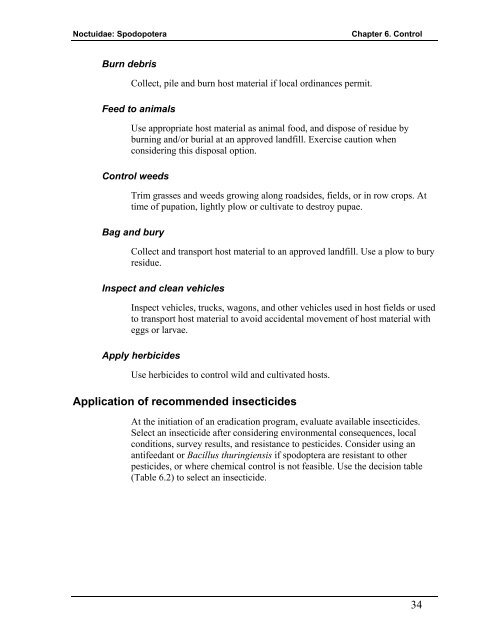New Pest Response Guidelines - Phytosanitary Resources
New Pest Response Guidelines - Phytosanitary Resources
New Pest Response Guidelines - Phytosanitary Resources
You also want an ePaper? Increase the reach of your titles
YUMPU automatically turns print PDFs into web optimized ePapers that Google loves.
Noctuidae: Spodopotera<br />
Chapter 6. Control<br />
Burn debris<br />
Collect, pile and burn host material if local ordinances permit.<br />
Feed to animals<br />
Use appropriate host material as animal food, and dispose of residue by<br />
burning and/or burial at an approved landfill. Exercise caution when<br />
considering this disposal option.<br />
Control weeds<br />
Trim grasses and weeds growing along roadsides, fields, or in row crops. At<br />
time of pupation, lightly plow or cultivate to destroy pupae.<br />
Bag and bury<br />
Collect and transport host material to an approved landfill. Use a plow to bury<br />
residue.<br />
Inspect and clean vehicles<br />
Inspect vehicles, trucks, wagons, and other vehicles used in host fields or used<br />
to transport host material to avoid accidental movement of host material with<br />
eggs or larvae.<br />
Apply herbicides<br />
Use herbicides to control wild and cultivated hosts.<br />
Application of recommended insecticides<br />
At the initiation of an eradication program, evaluate available insecticides.<br />
Select an insecticide after considering environmental consequences, local<br />
conditions, survey results, and resistance to pesticides. Consider using an<br />
antifeedant or Bacillus thuringiensis if spodoptera are resistant to other<br />
pesticides, or where chemical control is not feasible. Use the decision table<br />
(Table 6.2) to select an insecticide.<br />
34













